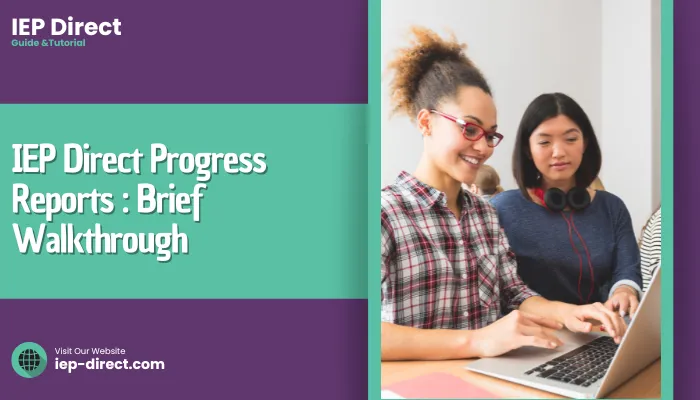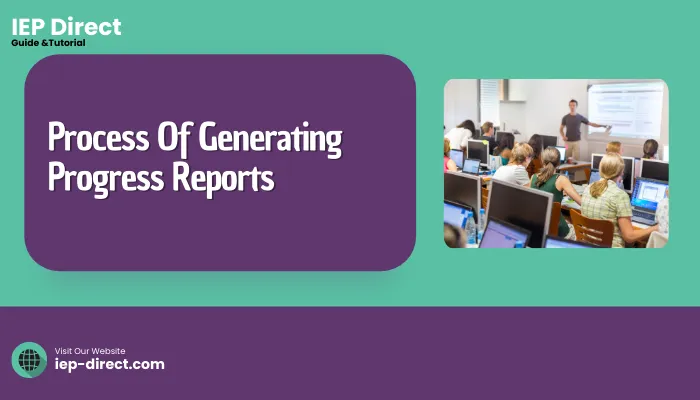IEP Direct progress reports do not get the attention they deserve in special education. These digital snapshots that capture their journey can provide invaluable insights into students’ learning progress monitoring IEP Direct.

This piece will expound on why they are important and how they can transform your approach to special education which can also relate to IEP Direct progress reports example.
By reading this guide, you will have a deeper understanding about how to take advantage of IEP Direct progress reports and IEP Direct progress reports example for a more impactful learning experience for your students.

IEP Direct Progress Reports Overview
An IEP Direct progress report is a digital tool used for progress monitoring IEP Direct and for providing IEP Direct progress reports example which lead to recording student’s Individualized Education Program (IEP) goals achievements.
It is essentially an ever changing document which provides a concise picture of children’s rise in studies, behavior, and other aspects over time.
Importance Of IEP Direct Progress Reports
The main reason for these types of reports is to provide a clear understanding of the subject matter.
Go through the point which have been mentioned.
- Inform decision-making: assessing learner development, educators can now make informed choices relating to instructional approaches, accommodations, modifications.
- Enhance communication: The goal of having clear and consistent messages being sent out through progress reports among teachers, parents, and students who should know about his or her educational journey.
- Promote accountability: Giving account on time shows commitment towards ensuring that the student meets the set goals within his/her individualized education plan.
Therefore, consider this points while understanding the purpose of IEP Direct Progress Reports.
How Progress Reports Fit
IEP Direct progress reports are one aspect in the cycle of an Individualized Education Plan (IEP). Below are where they come into play:
- IEP Development: Progress reports will help in identifying areas of need and suggesting suitable IEP goals.
- Implementation: educators keep an eye on students’ progress towards their IEP objectives through progress reports and adjust instructions as needed.
- Evaluation: Progress report data support developing future goals based on whether the previous ones have been achieved or not.
In summary, IEP Direct progress reports are crucial for setting goals, adjusting instruction, and evaluating progress in an Individualized Education Plan (IEP).
Key Features And Functionalities
IEP Direct progress reports come with several functionalities for effective tracking of student’s learning through progress monitoring IEP Direct.
Some key features are:
- Goal tracking: Set specific, measurable, attainable, relevant, time-bound (SMART) goals and monitor their attainment through time.
- Data collection: Gather various types of data such as grades, standardized test scores, anecdotal notes among others.
- Progress visualization: Display graphs, charts and other visual means to illustrate learning growth over a period.
- Reporting: Produce comprehensible progress records to parents, students and members of the IEP team.
- Collaboration: Share data with other team members in real-time or collaborate with them at any point in time.
In the next section, we will take a closer look at how to Generate Progress Reports in IEP Direct.

Process Of Generating Progress Reports
Creating informative and accurate IEP Direct progress reports is vital for progress monitoring IEP Direct, student progress while keeping parents informed as well as other stakeholders. Let us now go through the step-by-step process involved.
Accessing The Progress Report Section
To access the Progress Report section, log into your account, navigate to the Progress Report Module, and select the student for whom you want to generate a report.
- Log into your account: Type your login details so as to access the system.
- Navigate to the Progress Report Module: Look on the main menu for “Progress Reports” or something similar.
- Select the Student: Choose which student you want their progress report generated.
By following these steps, you can easily access and generate progress reports for your students.
Choosing Relevant Student Information
To choose relevant student information:
- Choose the Reporting Period: Determine how often the report is made (e.g., quarterly, semesterly, yearly).
- Select IEP Goals: Decide about which IEP goals are going to be involved in your report.
- Include Relevant Assessments: Choose from among test scores, classroom assessments results and other information that supports it.
- Add Anecdotal Notes: Integrate qualitative observations and specific examples of student performance.
By selecting the relevant student information, you ensure that the progress report is comprehensive and tailored to the student’s needs.
Customizing Report Formats And Details
To customize report formats and details:
- Choose a Template: Go for an already designed template or design a format yourself.
- Customize Sections: Add or remove sections as per your student’s needs.
- Adjust Formatting: Change font size, spacing, layout etc. to make it readable
- Include Visuals: Use graphs/charts/images for better understanding of content
By customizing the report format and details, you create a clear and personalized progress report that effectively communicates the student’s performance.
General Settings And Options
In the general settings and options:
- Progress Bars: Progress bars will show how close students are to reaching their goals;
- Data Tables: Tables with numbers that are easy to read;
- Comments: Adding explanations to data presented or putting it in context;
- Parent/Guardian Access: Who can view this progress report?
By adjusting these general settings and options, you ensure the progress report is informative, clear, and accessible to the right people.
Tips For Accurate And Efficient Reporting
Here are tips which will led you to make perfect reporting as well as increasing the efficiency of reporting.
- Consistency: Use the same mechanisms of reporting
- Timeliness: Generate reports without delays so that they convey up-to-date information;
- Collaboration: Engage other members in the creation process of this document;
- Clarity: Write concise language that is clear enough;
- Positive Focus: Highlight achievement areas as well as weaknesses/deficiencies/points for improvement
By following these steps and incorporating best practices, you can create IEP Direct progress reports that effectively communicate student progress and inform decision-making.
Types Of Progress Reports In IEP Direct
IEP Direct has many types of progress report templates that cater to different needs. Let’s look at what each type entails and when it should be used for IEP Direct progress reports example
Standard Progress Reports
These reports give a general idea of how the student is progressing towards their IEP goals.
They usually include:
- Student information: i.e., name, grade, date of birth, etc.
- IEP goal summary: List of annual goals for the student;
- Progress data: Quantitative and qualitative information showing movement toward goals;
- Summary of strengths and areas for improvement: Brief overview on how the student performed
When to use:
- Checking everyday students’ achievement rate,
- Giving parents general information,
- Getting ready for IEP meetings.
Therefore, what is included in this report and when to use it everything is mentioned properly.
Customizable Progress Reports
With customizable reports, you can change things according to what you need. You may do the following:
- Select specific goals: Focus on certain areas of concern or excellence.
- Include additional data: Add assessments, observations, and other relevant details.
- Modify the format: Change layout; font and visual elements based on your preferences.
When to use:
- Analyzing student performance in detail
- Sharing comprehensive information with parents or other stakeholders
- Documenting specific interventions or accommodations
In short, customization reports are good to go in terms of your needs.
Comparison With Other Types of IEP Reports
While the value of IEP Direct progress reports cannot be underestimated, it’s important to understand how they differ from other types of IEP-related reports:
| Report Type | Purpose |
|---|---|
| IEP Direct Progress Report | Monitors students’ progress in response to their IEP goals |
| IEP Summary | Gives an overview of what is currently on a student’s IEP |
| Triennial Evaluation Report | Determines whether or not a student is eligible for special education services |
| Present Levels of Performance (PLP) | Describes the existing abilities and weaknesses of a student in academics, social skills, and developmental areas |
Therefore, for better understanding refer this table.
When & Why Should You use Each Type ?
The kind of report you will choose will depend on your particular needs. Here’s a general guide:
- Standard progress reports: Routine monitoring and general communication.
- Customizable progress reports: Analysis, specific concerns, detailed communication.
- IEP summary: A brief mention about the student’s IEP.
- Triennial evaluation report: To determine eligibility for special education services.
- PLP: Describes the current performance status of the student hence informing development of IEP goals.
By understanding the different types of IEP reports / IEP Direct progress reports example available, you can effectively communicate student progress and make data-driven decisions to support student success.
For perfect understanding I have created tables so that you can understand it better.
| Efficiency and Time-Saving Aspects | Description |
|---|---|
| Centralized Data Storage | All student data is stored in one place, eliminating the need for paper files and manual data entry. |
| Automated Reporting | IEP Direct can generate progress reports with just a few clicks, saving valuable time for educators. |
| Template Utilization | Use pre-built templates that are easily customizable to reduce report creation time. |
| Data Import | Streamline the reporting process by importing data from external sources such as standardized tests. |
| Enhanced Data Accuracy and Consistency | Description |
|---|---|
| Real-time Updates | Changes made to student information or goals are reflected immediately in progress reports. |
| Data Validation | Built-in checks help ensure data accuracy and consistency. |
| Standardized Formats | Consistent reporting formats promote clear and comparable data. |
| Data Visualization | Charts and graphs give visual displays of students’ performances, facilitating prompt identification of trends and patterns. |
| Integration with Other IEP Direct Features | Description |
|---|---|
| Goal Management | This links back to IEP goals enabling easy tracking and analysis through Progress Reports. |
| Assessment Management | Progress Reports which include assessment data provide holistic views of student performance. |
| Communication Module | Share progress reports with parents and other stakeholders through the IEP Direct platform. |
| Document Storage | Store supporting documentation alongside progress reports, such as student work samples. |
Therefore, refer all the tables for which reporting should we use for increasing our maximum efficency.

Troubleshooting Common Issues
However superb a tool is; sometimes it may experience some challenges. Here are some common problems that you may face when generating IEP Direct progress reports/progress monitoring IEP direct and how to overcome them.
Common Problems Users Face
There are many problem which user face day to day, in this section everything has been mentioned, have a good look:
- Data Entry Errors: Incorrect or missing data can lead to inaccurate progress reports.
- Report Generation Issues: Difficulties in creating or accessing reports.
- Technical Glitches: System errors or slow performance.
- Data Import Problems: Issues with importing data from external sources.
- Access Permissions: Problems with user roles and permissions.
As you have seem this are the error which user face, but don’t worry solution is also given.
Solutions And Tips For Resolving Issues
Check out this solution for resolving your issues:
- Double-Check Data: Carefully review all entered data for accuracy and completeness.
- Clear Browser Cache and Cookies: Sometimes, a simple refresh can resolve display issues.
- Check Internet Connection: Ensure a stable internet connection for optimal performance.
- Contact Support: If the problem persists, reach out to IEP Direct support for assistance.
- Update Software: Ensure you’re using the latest version of IEP Direct.
- Seek Online Resources: Explore online forums or knowledge bases for troubleshooting tips.
Therefore, whenever you face any problem you can refer this points so that you won’t face any problem.
Contacting Support For Help
If you’ve tried troubleshooting on your own and still encounter difficulties, it’s time to contact IEP Direct support. Here’s what you can expect:
- Gather Information– Error messages, screenshots, steps taken should be noted down which will help support team understand what went wrong easily.
- Contact Support – Get in touch with the support team through their given contacts.
- Provide Clear Explanation– Clearly describe the problem and the steps you’ve taken to resolve it.
- Follow Up: Follow up with support team, if not immediately solved, to ensure progress.
To make your experience with IEP Direct less disruptive and more productive, follow these troubleshooting steps by knowing the common problems. Don’t forget that help can be sought from the support team in case you face challenges.
By using this tricks your customer service experience will be good and lot better.
Frequently Asked Questions (FAQs)
IEP Direct progress reports are a crucial tool for tracking student progress, but you might have questions about how to use them effectively. Here are some common queries and their answers:
Q. How often should I generate progress reports?
A. While there’s no strict rule, it’s generally recommended to generate progress reports at least quarterly. However, the frequency can vary based on factors like the student’s IEP goals, grade level, and specific needs. More frequent reports might be necessary for students with significant needs or those making rapid progress.
Q. Can I share progress reports with students and parents?
A. Absolutely! Sharing progress reports with students and parents is encouraged. It promotes transparency, fosters collaboration, and keeps everyone informed about the student’s educational journey. IEP Direct usually provides options for sharing reports digitally or in print.
Q. How can I monitor my progress in attaining long-term goals?
A. Monitoring progress in achieving long-term goals involves breaking them down into smaller achievable steps or benchmarks. Within IEP Direct there are data visualization tools that are used to make graphs or charts showing the progress over time. These visual aids should be periodically reviewed and updated so that the student’s education is informed by them.
Q. Can I change how my progress reports appear?
A. Yes, most IEP Direct systems have options for doing so. It is often possible to modify such things as the report’s structure, typeface, and even its content. This allows you to customize your report to reflect specific requirements for students, parents, and guardians.
With proper utilization of IEP Direct progress reports, we are able to better monitor student performance, use data effectively and support student success.
Conclusion
IEP Direct progress reports through IEP Direct are very essential for any concerned teacher who wants a successful outcome of a learner. When used efficiently, these reports can enable teachers to:
- Simplify Collection of Data and Its Analysis
- Broaden Communication with Parents and Stakeholders
- Facilitate Decision Making about Instructional or Intervention Approaches
- Demand Responsibility while Sticking to Transparency Norms
Remember that more than just pieces of paper; these documents outline growth and development of learners as well. With IEP Direct’s power at their disposal, every student has an opportunity for a brighter tomorrow.
Contents
